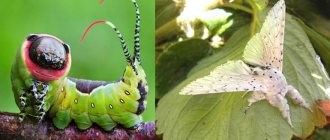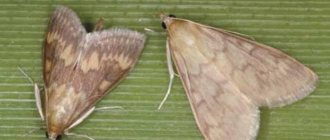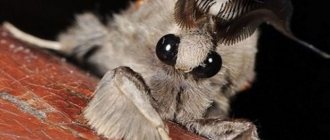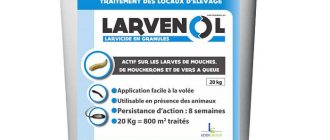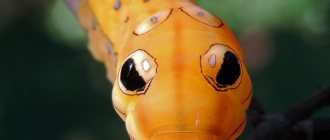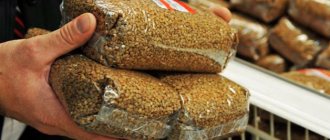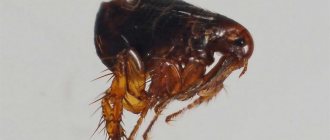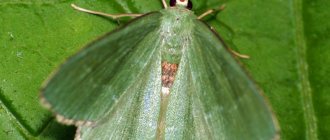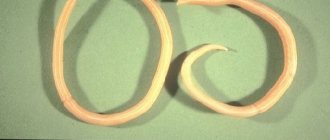The expression is often used: moths have ruined things. Moreover, this applies not only to clothing, but also to food. It is not the adult butterfly itself that causes harm, but the moth larvae. It is they who cause maximum damage, devouring large quantities of groceries and furs. They do this in order to keep the adult alive for as long as possible.
Moth damaged carpet.
Type and species differences
It is generally accepted that moths are a certain common pest, but depending on their appearance and lifestyle, as well as dietary preferences, several types of pests are distinguished. Although they may look exactly the same, they do have differences.
To see what a moth larva looks like, you can unwrap a cocoon or a grocery pellet. There will undoubtedly be a small larva or pupa there.
food moth
Food moth larva.
Food moths are those that feed on various groceries. Therefore, you don’t have to worry if you accidentally discovered nasty larvae in old pea stocks, and that your fur coats will also be damaged. Other species are responsible for the fur. Food moths are found in cookies, sweets, dried fruits, nuts or flour. The structure of the jaws allows them to feed on even the largest and densest pieces.
Food moth larvae look like white or even translucent worms. If you look closely, you can see a head, two pairs of legs on the first segment of the body, and four more pairs on the abdomen.
It usually reaches 20 mm in length, but its thickness depends on the dish in which it grew and developed. On fatty, nutritious foods it will be much greater.
These pests do not disdain anything. They can live anywhere where there are suitable conditions and food. Even on an industrial scale, it happens that moths eat up huge reserves of food.
Clothes moth
Moth marks on clothes.
Accordingly, the situation is the other way around. The clothes moth larva prefers to feast on things that contain keratin. These are woolen clothes, fur coats, carpets, feather and down pillows, hair, felt products. The larvae are whitish or gray, build a small house out of what they live in, wrap themselves up and wait there to transform into a butterfly.
They can be detected by holes in clothing, fur items, small pellets on woolen items that are cocoons, or in carpets and furniture upholstery, where they make entire passages. Surprisingly, shoes are also eaten by food moth larvae, especially those made of felt or natural fur.
If such residents are found, then you don’t have to worry about the kitchen: they eat only certain foods.
Life cycle
During its life, the pest goes through four different stages of development. There should be very comfortable conditions for them. This is an average of room temperature and dryness.
Moreover, moth larvae that live in foods develop much faster due to a more balanced diet.
- Moth eggs are small and almost invisible; they hatch into larvae or caterpillars, which cause the greatest harm.
Life cycle of a moth.
They have powerful mouthparts and their main goal is to store enough nutrients to pupate and then turn into a butterfly.
- After the larva has eaten enough, it builds itself a cocoon, protective and cozy, in which it will undergo the pupation period.
- A butterfly flies out from this place and immediately sets off to find a partner for mating. If it is a male, then after mating he will die immediately. The female will lay eggs and also die.
- After the eggs are laid, and there can be even 200 of them, small hungry larvae appear within a week or 10 days.
Lifespan
Hardly anyone thought about how long a moth lives. She cannot be considered a long-liver. The total lifespan of a winged individual is from 2 to 4 weeks, depending on the type of moth. Insects move and fly little. The main activity occurs at dusk, as they are good prey for any predator.
To reach sexual maturity, the moth must go through certain stages of development:
- the female lays eggs twice a year, from which caterpillars appear two weeks later, the temperature is +20 degrees, which is favorable for the development of offspring;
- Moth larvae form a nutritious cocoon around themselves, where they develop for 3-10 months.
If we consider the full life cycle of an insect, then moth eggs go through a long stage of development to the state of an adult, all this time feeding on the materials and products in which they live.
Nutrition
The appearance of moth caterpillars can be very deceiving. They are voracious and can cause significant harm. In human housing, the conditions for them are the most comfortable, compared to ordinary natural conditions, which is why they often appear on shelves in hordes.
There is an important feature of the food moth : it does not prefer certain foods. For example, having got into a jar of rice and quickly destroyed it, the worm happily moves into flour or wheat grits.
The situation is also the same for clothes moths . If the fur coat is destroyed, and the owner has not yet given it another coat, then she can switch to a more unbalanced diet, for example, on a carpet. If the situation is extremely difficult, there are no carpets, then pests can even use semi-synthetic things.
Why is the parasite dangerous?
Moths do not bite people or domestic animals and are not carriers of diseases. It causes significant harm to humans, as it spoils food supplies, clothing, and household utensils in large quantities.
Favorite “dishes” of insects:
- cereals, flour, pasta supplies;
- cookies, crackers;
- nuts, seeds.
With pleasure, the moth eats available supplies of sweets (for example, candy). In places where it settles, there is a sticky web and microscopic scales. Worm larvae, with their powerful jaws, are able to gnaw through entire tunnels in food supplies, simultaneously filling them with their own excrement.
The moth causes severe damage to things in which it manages to lay eggs. It can be:
- carpeting, upholstery of upholstered furniture made from natural fabrics (especially those with a high wool content);
- woolen sweaters, jackets, socks, scarves, hats, mittens, down scarves;
- fur coats, jackets, hats.
If the reproduction of moths is not stopped in time, a horde of larvae can be turned into a fur coat completely unusable during the summer season. The larvae eat away entire bald spots on fur, make holes in woolen materials, and leave holes in sofas and armchairs.
The larva of a food moth will mature in 5 weeks, and a clothes moth in 3 months before turning into a cocoon pupa, from which a gray velvety butterfly moth will subsequently hatch. The butterfly will no longer eat food and clothing, but during its short three-week life it will have time to lay a new batch of eggs.
Reproduction and development
One moth can lay about 200 eggs. This is a very large offspring. Moreover, very voracious caterpillars emerge from these eggs quite quickly. Do not delude yourself that they cannot cause significant harm. Given their number, even one offspring can destroy significant food supplies or a number of things.
Moth caterpillars.
Preventive measures
The best way to prevent the recurrence of food moths in the home is to be careful when purchasing groceries. It is better to purchase cereals in transparent packages so that you can visually assess their quality. Extraneous inclusions, small lumps, thin cobwebs are signs of food moth infestation.
It is better to heat flour or cereal purchased at a big discount in the oven at a temperature of +80...120°C for 30 minutes or place it in the freezer overnight.
It is advisable to pack all bulk products in hermetically sealed containers so that food moths cannot reach them. Cabinets need to be cleaned regularly in order to promptly get rid of stitched or insect-infested cereals. Kitchen furniture shelves should be wiped from time to time with a strong solution of vinegar, which...
Next MothHow to get rid of poplar moths in an apartment
Measures to combat moth larvae
If larvae were found in supplies or on things, you need to get ready for cleaning. The struggle process will be quite long and tedious. First of all, it will be necessary to conduct a complete audit: throw away heavily contaminated items, destroy food.
Pests in grocery.
After this, it is important to clean it. All cabinet shelves should be thoroughly washed, and things should be washed at a temperature above 50 degrees, if possible. And if things cannot withstand such a load, you need to freeze them for a day and then rinse them.
The same applies to food cabinets. Of course, you can choose from large stocks what remains intact, but the cereals need to be calcined at a temperature of 60 degrees or frozen for a week. If a large volume is hopelessly spoiled, then it is better to throw everything away immediately. All surfaces should be washed with soapy water and vinegar.
Chemicals
Sticky trap.
Chemicals are an excellent method for getting rid of moth larvae. It is quite fast and proven - these are special insecticides. They have a slightly different composition and operating principle, so everyone will choose what they need for themselves:
- Armol . It affects the pest at any stage of development, destroys both butterflies and larvae, and is effective against house and kitchen moths.
- Raptor. Unlike many insecticides, it has a pleasant smell, but it mainly destroys only clothing pests. Destroys mainly only pests.
- Fumigators. They act slowly, but are safer. It will take about 7 days to completely destroy them. But they do not emit any aroma and are completely safe.
You need to choose them depending on the scale of the damage.
Folk remedies
Of course, many people prefer folk remedies, but they are more effective on butterflies and will not destroy the larvae. But for the purpose of prevention and prevention of re-infection, they can be used:
- Essential oil of lavender, rosemary or clove.
Fragrant wreath of herbs.
- Small bouquets of tansy, wormwood, chamomile, tobacco, lavender or wild rosemary will help protect your closet or cabinet from gluttonous guests.
- Plant pelargonium on the window, its aroma will repel moths, and they will not get into the house.
- Laundry soap works very well to repel pests in the closet.
- You can use these products in combination and after washing the shelves with laundry soap, hang bouquets of dried flowers in the closet.
More information on how to deal with larvae and adult moths in an apartment can be read in the article at the link.
How to get rid of food moth (video)
After reaching a certain size, the larvae make a cocoon from the web and turn into pupae.
They are dark in color and measure 6-9 mm. We invite you to read the article posted on our website.
How to detect larvae
Moth larvae lead an extremely motionless lifestyle and are difficult to see immediately. Moreover, they can blend in color with the cereals and flour in which they have settled. You can detect that products are contaminated by the following signs:
- rot appeared in the products;
- in the provisions, glued lumps with cobwebs are clearly visualized;
- there are dry discarded skins.
The larvae can live in granaries and enter homes along with food.
Fighting methods
- To get rid of food moths, Raptor traps and adhesive tapes are used.
- You can also place repellent herbs, garlic, and bay leaves in cabinets.
- The most important thing is to immediately get rid of spoiled and suspicious products.
Prevention measures
Prevention is more effective and cheaper than later getting rid of rodents on clothes or products. There are a number of simple requirements that are easy to fulfill:
- Periodic wet cleaning.
- Regularly review the condition of your closet and belongings.
- Place bulk products in closed jars, and fur products in thick plastic covers.
- If possible, it is better not to create large stocks of food, because this is very tempting for pests.
- It is also better to remove old items that have been lying in the wardrobe for a long time.
- You can hang small bags of herbs in the closet with things, and put chopped citrus peels in the food closet.
Appearance
What does 1 common mole look like? This moth has a yellow color - gray or dark. A red tint is sometimes visible on the body of this insect.
Such a parasite has 2 pairs of shiny wings that shimmer in the sun. A fringe is visible along its edges. The span of the front wings of such a moth is 9–18.5 mm. The hind wings are more uniform in color and smaller in size.
The chest of such a small pest is brown on top and light yellow and shiny below.
The male of this insect is smaller than the female, and after mating with the female and fertilizing her, he quickly dies. The female of this small pest lives for about 1 month.
How to deal with fleas in the sofa
The fleas that have taken a liking to your sofa do not live only on it - they travel throughout the entire apartment. Fleas often come to the sofa to “refresh” while you are resting there, becoming an easy victim for them. Therefore, not only upholstered furniture - sofas, armchairs, modular systems, etc. - should be treated with special means, but also floors, walls, cabinets, tables.
To combat fleas, you should choose contact (rather than intestinal) insecticides, since these insects do not eat poison due to the special structure of their mouthparts. Therefore, contact substances and products based on them act on fleas:
- DDT;
- Chlorophos;
- Karbofos;
- Lindan.
The most effective products are Sinusan, Gett (Master-250), Raptor and Raid aerosols . If you prefer more natural formulations, you can use Pyrethrum , made from chamomile - it is the safest and most reliable.
It is very advisable to carry out anti-flea treatment for your pet at the same time as treating the furniture and apartment. Of course, the ideal option would be to remove it from the apartment for a while (two weeks or even a month) to avoid the risk of poisoning.
It is also important to know that 5-7 days after treating the premises, fleas may appear again - a new generation will arrive, hatching from previously laid eggs. In this case, re-treatment may not be necessary - the “young guard” most likely will not survive on already treated surfaces. A similar story can repeat itself on the 12th–14th day, and also (in rare cases) on the 21st.
What is more dangerous - the larva or the adult?
It is difficult to compare the amount of damage caused by different stages of the life cycle of house moths, as well as to draw any analogies between the two species.
The food variety, organizing its nest in an open packet of flour, renders the product completely unusable, and the larvae crawl into other products before pupating.
If we talk about the moral side of the issue, then house moths, especially in huge quantities, are a sign of carelessness and sloppiness of the owners. Only a careful and regular inspection of the contents of cabinets can ensure the complete absence of pests, and modern industry produces quite a lot of different preventive repellents that will help preserve household products and personal belongings.
Getting moths out of the sofa
You can fight moths that have settled in upholstered furniture using a variety of special “anti-moth” products - many of them are designed specifically for spraying sofas and upholstered armchairs.
In addition, moths are afraid of strong odors emitted by:
- orange and lemon peels;
- tobacco leaves and shag;
- St. John's wort, lavender, geranium, wormwood;
- essential oils - lavender and eucalyptus.
Citrus peels, fragrant plants and rags soaked in essential oils are laid out on sofas, armchairs and couches, and also placed in wardrobes so that moths have nowhere to hide from unbearable odors. Of course, these traditional methods require patience and do not act as quickly as special chemical compounds, but the result will please you.
But you shouldn’t “freeze” moths out of furniture by leaving the windows open in frosty weather. Most moth larvae will simply “freeze” (go into suspended animation) from the cold, and when you return and warm up the room, they will come to life again and return to their normal business of eating your furniture and other things.
We hope that these useful tips from “ZLATAMEBEL” will be useful to you in the event of an invasion of unwanted animals. We have been producing straight and corner sofas, couches, modular systems and upholstered furniture for home theaters for 15 years, so all our recommendations are professional, and their use will not cause any harm to the upholstery and filling of your furniture.
All furniture from our production is provided with an 18-month warranty and post-warranty service. Also, the ZLATAMEBEL brand invites you to ongoing sales, where you can purchase upholstered furniture of the highest quality at affordable prices.
Causes of appearance and damage caused
Usually people don’t even understand how moths start in an apartment, because all precautions are taken. But it’s difficult to completely protect your home from an uninvited guest.
There are three ways to introduce the parasite into a living space.
- With shopping. You can introduce the pest yourself when purchasing outerwear made of fur, woolen products, or when purchasing used furniture. Moreover, you will not see the individual itself - moths usually start from larvae in an apartment.
- With pets. Walking cats and dogs can carry moth eggs on their fur. The case is rare, but possible.
- Through ventilation. Butterflies are well versed in the ventilation system. If the clothes moth is infested with your neighbors, then it can get to you through the bars.
The caterpillar stage of the parasite is the destructive stage of the moth's life. The larvae gnaw large holes in warm sweaters and outerwear. Damage can most often be noticed in hidden places: under cuffs or collar. The caterpillar will eat any thing made from natural fibers, and will not refuse synthetic products if they contain at least some percentage of wool.
There is a book moth that doesn’t mind feasting on bindings and pages. When searching for an infestation, be sure to look through magazines and newspapers.
Peculiarities of moth reproduction
Moths have 4 stages of development. The timing of the stages varies and depends on the type of insect and its living conditions.
The development cycle of the lepidopteran parasite consists of a number of stages:
- egg laying;
- hatching of larvae;
- transformation of a caterpillar into a pupa;
- adult.
At a time, the female lays 40-200 eggs, up to 1 mm in size. Further development of eggs is regulated by temperature. On average, the process lasts up to 3 weeks.
Experts know how moth larvae appear. The caterpillar hatches from the egg. The worm has a transparent skin, and its body length reaches 1 mm.
The caterpillar goes through several stages of molting and then becomes a pupa.
For pupation, insects choose hard-to-reach, dark places. But some types of lepidoptera prefer bright places.
Many species of house moths make a cocoon for themselves. This is a cover woven from a substance resembling silk. In a protective cocoon, the larva is in the pronymph state, and then it molts.
The integument of the pupa hardens over time. The shell protects the insect until it transforms into a butterfly (up to 14 days).
The lifespan of an adult is up to 3 weeks. During this time, she mates, looks for food for the larvae, and leaves offspring.
What do moth pupae eat?
Moth caterpillars eat a wide variety of things and foods. If in nature they eat bird feathers, animal hair, nuts, vegetables, grains, berries and fruits, then in an apartment their menu becomes much richer. This list includes furs, fabrics made from cotton, silk, flax, wool, as well as human hair. The main thing is that the materials are natural and old - they are easier to chew and digest. Parasites are especially attracted to clothes soaked in sweat and carpets with liquid spilled on them. In such places, the larvae receive not only food, but also water.
Among the food products moth pupae prefer:
- Muke;
- Bran;
- Mahnke;
- Krupam;
- Liver;
- Nuts;
- Seeds;
- Dried fruits;
- Tea;
- Candy;
- Pasta.
Of course, the caterpillar's stomach is not capable of accepting large amounts of food. She eats very little, so small damage can go unnoticed for a long time. The problem is that there are a huge number of pupae in the brood. After such a feast, things or food will simply have to be thrown away.
